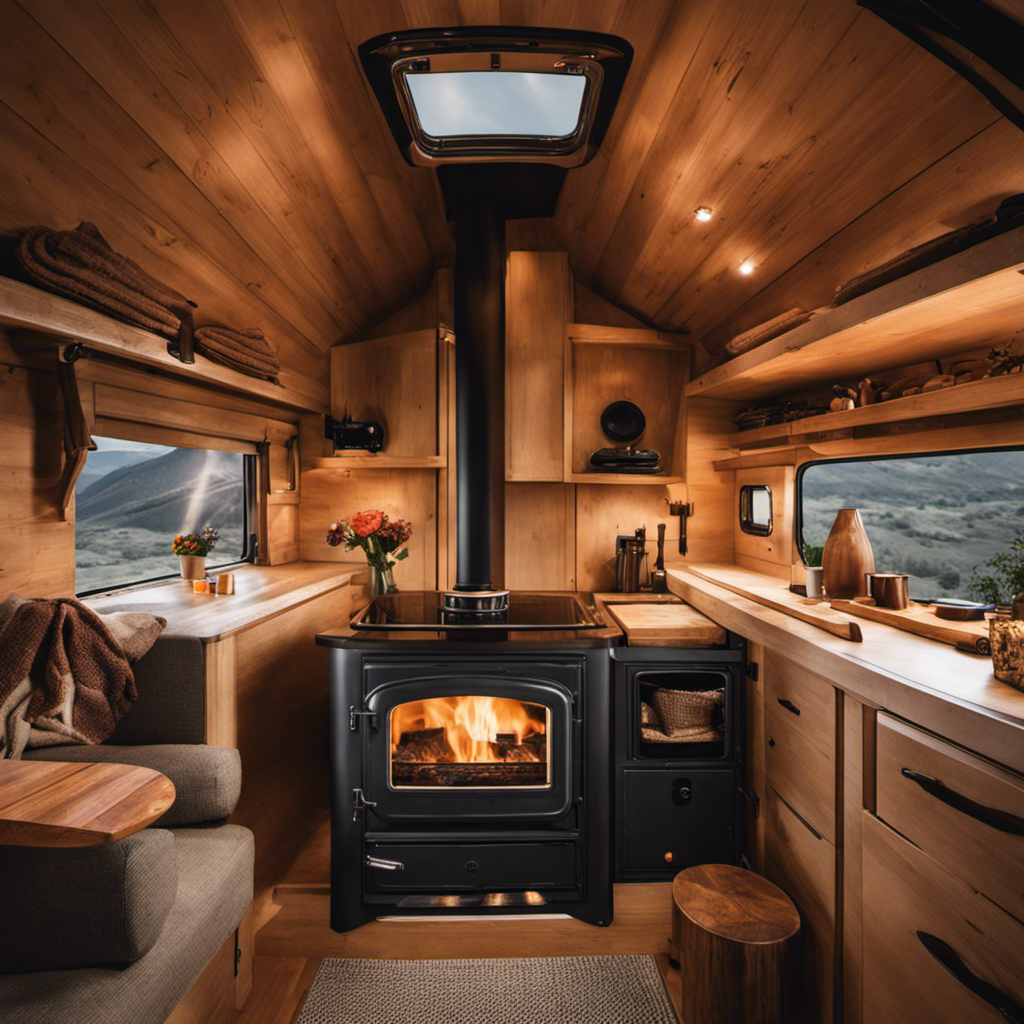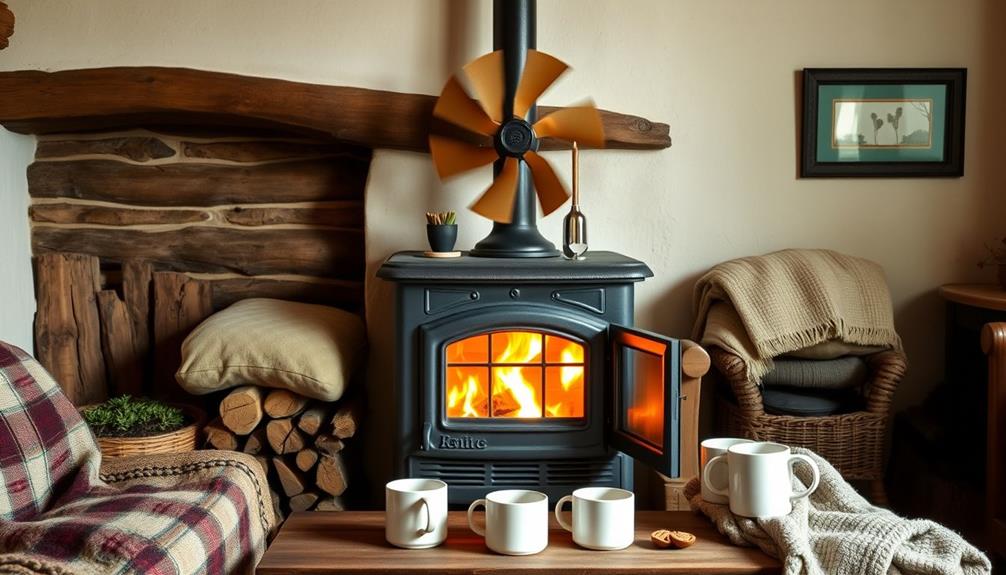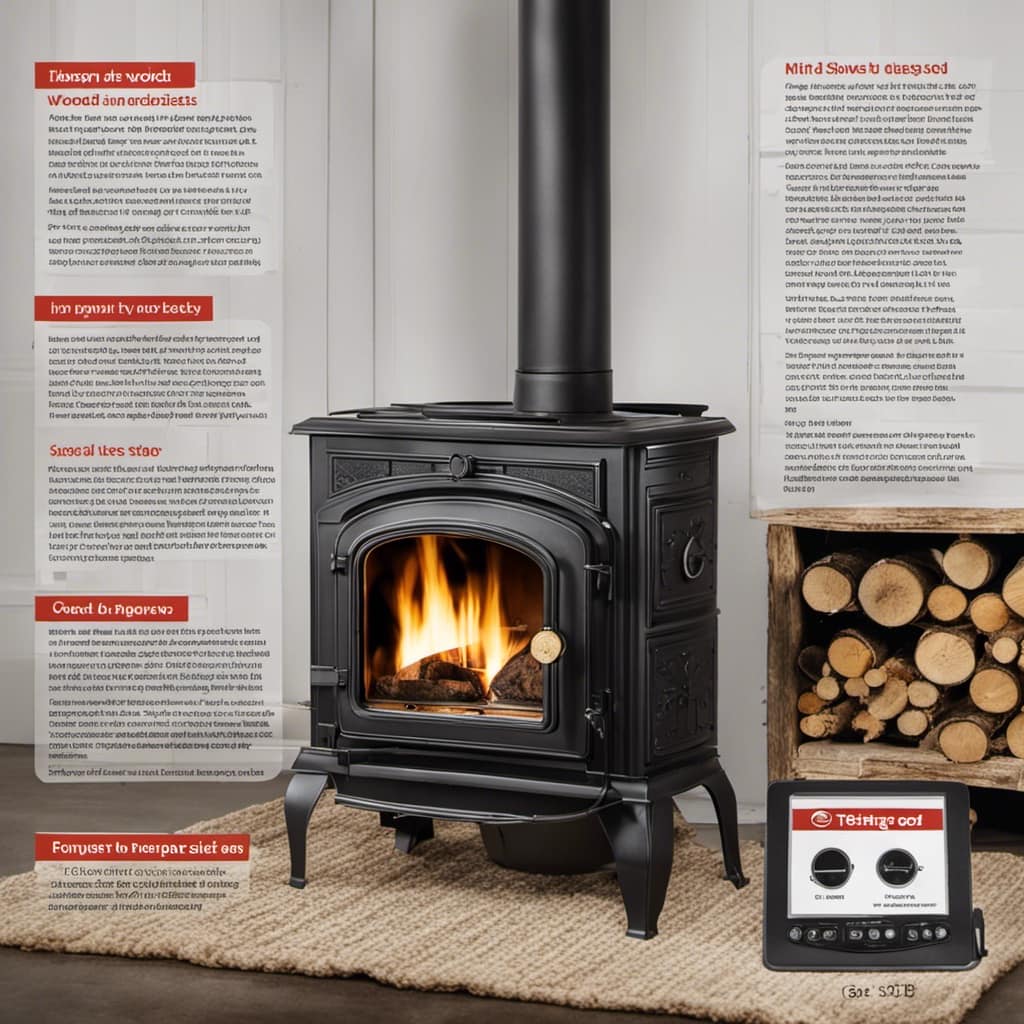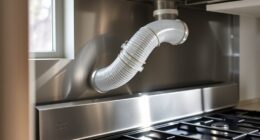As a person who has a strong love for wood-burning stoves, I truly enjoy the cozy evenings spent next to the crackling fire. However, maintaining a strong fire requires more than just throwing wood into the stove. It’s a delicate balance of creativity and precision.
In this article, I’ll share my secrets for maintaining a roaring wood stove fire. From selecting the perfect wood to mastering airflow and ventilation, I’ll guide you through every step.
Get ready to stoke the flames of warmth and learn how to keep your wood stove burning like a pro.
Key Takeaways
- Seasoning wood improves efficiency and heat output
- Properly storing seasoned wood prevents moisture absorption
- Regular chimney maintenance prevents blockages and fires
- Adjusting the damper controls temperature and burn rate
Choosing the Right Wood
I personally find it crucial to carefully consider the type of wood I use, as it greatly impacts the efficiency of my wood stove.
One important factor to consider is seasoning wood. Seasoned wood refers to wood that has been allowed to dry for a certain period of time, typically around 6-12 months. This drying process removes excess moisture from the wood, making it burn more efficiently and produce more heat.
It’s important to store seasoned wood properly to maintain its quality. I always make sure to stack my wood in a well-ventilated area, off the ground, and protected from rain and snow. This helps prevent the wood from absorbing moisture and ensures that it remains dry and ready for use in my wood stove.
Choosing properly seasoned and well-stored wood is essential for maximizing the performance of my wood stove.
Proper Airflow and Ventilation
The proper airflow and ventilation in my wood stove are crucial for maintaining a safe and efficient burning process. When it comes to keeping my wood stove burning effectively, airflow efficiency is key. Here are three important factors to consider for achieving optimal airflow and troubleshooting common issues:
-
Clean the air vents: Over time, dust and debris can accumulate in the air vents, obstructing the airflow. Regularly cleaning these vents ensures proper ventilation and helps prevent smoke from entering the room.
-
Adjust the damper: The damper controls the amount of air entering the stove. Adjusting it can regulate the burn rate and maintain a steady flame. Opening the damper fully during ignition and gradually closing it once the fire is established helps achieve efficient burning.
-
Use the ash pan: Removing excess ash from the stove’s bottom helps maintain proper airflow. Excessive ash buildup can restrict air circulation, leading to poor burning efficiency.
Maintaining a Clean and Clear Chimney
Regularly sweeping and inspecting my chimney is essential for preventing dangerous blockages and ensuring proper ventilation. Chimney fires are a serious risk if the chimney isn’t properly maintained.
Over time, soot and creosote can accumulate in the chimney, which can ignite and cause a fire. Regular inspections can identify any potential issues or blockages in the chimney, allowing them to be addressed before they become a hazard.
During an inspection, a professional chimney sweep will thoroughly clean the chimney, removing any buildup of soot and creosote. They’ll also check for any cracks or damage to the chimney liner, which can affect its ability to properly vent the smoke and gases.
Managing Temperature and Draft Control
Although it can be challenging, I find that adjusting the damper is crucial in managing temperature and draft control. With the right technique, you can effectively regulate the temperature in your wood stove and troubleshoot common issues.
Here are three key steps to help you achieve optimal temperature regulation:
-
Start with the damper: The damper is a small metal plate located above the firebox. By adjusting the damper, you can control the amount of air entering the stove, which directly affects the temperature. Opening the damper allows more air to enter, resulting in a hotter fire, while closing it reduces the airflow and lowers the temperature.
-
Monitor the fuel: The type and amount of fuel you use can also impact temperature regulation. Hardwoods like oak and maple burn longer and produce more heat, while softwoods like pine burn faster and at a lower temperature. Additionally, maintaining a consistent fuel load is essential for steady heat output.
-
Check for drafts: Drafts can interfere with temperature regulation, causing the stove to burn too hot or too cool. Inspect doors, windows, and vents for any gaps or leaks that may let cold air in or allow warm air to escape. Using weatherstripping or caulk to seal these areas can help maintain a stable temperature inside the room.
Tips for Efficient Wood Stove Operation
I find that by carefully adjusting the airflow and regularly removing ashes, I can ensure efficient wood stove operation.
When it comes to fuel efficiency, it’s important to use dry, seasoned wood. Moisture content in the wood can significantly reduce the stove’s efficiency and produce more smoke emissions. By using well-seasoned wood, you can achieve a clean and efficient burn.
Additionally, controlling the airflow is crucial for both fuel efficiency and reducing smoke emissions. I recommend using the stove’s air vents to regulate the amount of oxygen entering the firebox. This allows for complete combustion and helps minimize smoke production.
Regularly cleaning out the ashes is also important as it allows for better airflow and prevents the build-up of creosote, a highly flammable substance that can lead to chimney fires.
Frequently Asked Questions
How Often Should I Clean My Wood Stove and Chimney?
I clean my wood stove and chimney about once a year to ensure it operates effectively. Regular cleaning is important to prevent creosote buildup and reduce the risk of chimney fires.
Can I Burn Any Type of Wood in My Wood Stove?
To keep a wood stove burning efficiently, it’s important to use the right type of wood. Properly stored wood that is dry and seasoned will provide the best results and help maintain a consistent heat output.
What Should I Do if My Wood Stove Is Not Producing Enough Heat?
To troubleshoot wood stove heat production, I recommend checking the maintenance of your wood stove. Clean the chimney, ensure proper air circulation, and use dry hardwood logs. These steps can help improve heat output.
Are There Any Safety Precautions I Should Take When Operating a Wood Stove?
When operating a wood stove, it’s important to prioritize safety. Some common mistakes to avoid include leaving the stove unattended, using improper fuel, and failing to properly clean and maintain the stove.
How Can I Prevent Creosote Buildup in My Chimney?
To prevent chimney fires and remove creosote buildup, it’s important to clean the chimney regularly. Use a chimney brush to scrub away the creosote, and consider professional inspection and cleaning for thorough maintenance.
Conclusion
In conclusion, maintaining a wood stove requires careful attention to detail to ensure optimal burning. By selecting the right wood, ensuring proper airflow and ventilation, keeping the chimney clean, and managing temperature and draft control, you can enjoy efficient and consistent heat.
So, remember to keep the fire burning like a well-oiled machine, and your wood stove will be the heart and soul of your cozy home.
Growing up surrounded by the vast beauty of nature, Sierra was always drawn to the call of the wild. While others sought the comfort of the familiar, she ventured out, embracing the unpredictable and finding stories in the heartbeat of nature.
At the epicenter of every remarkable venture lies a dynamic team—a fusion of diverse talents, visions, and passions. The essence of Best Small Wood Stoves is crafted and refined by such a trio: Sierra, Logan, and Terra. Their collective expertise has transformed the platform into a leading authority on small wood stoves, radiating warmth and knowledge in equal measure.











